
Thallus
Shape is important because 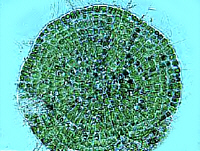 plants need to
minimize water evaporation. A sphere has the least amount of
Surface Area / Volume ratio.
plants need to
minimize water evaporation. A sphere has the least amount of
Surface Area / Volume ratio.
A flat sheet has the greatest Surface Area / Volume ratio.
Water would evaporate more
readily from the sheet because more molecules are in direct contact with the atmosphere.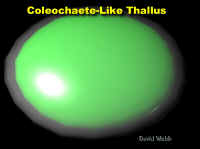
However, plants need to perform Photosynthesis in order to survive. Consequently, plants need to maximize their surface area to intercept as much light as possible. The process of evolution has selected plants which are best able to balance these two conflicting needs.
The first land plants probably  resembled a discus which was thin at the margins and thick
in the middle. This is similar to certain Green Algae (Coleochaete). However,
this shape has a relatively large Surface / Volume ratio.
resembled a discus which was thin at the margins and thick
in the middle. This is similar to certain Green Algae (Coleochaete). However,
this shape has a relatively large Surface / Volume ratio.
Some Thallose Liverworts (Anthoceros) have a shape like this but there are no large land plants with this kind of shape. Consequently, other shapes must have had greater adaptive value.
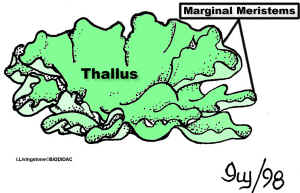 |
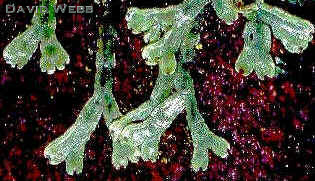 |
| Diagram of Anthoceros Thallus: This resembles a frilly Discus. | Marchantia has a strap-like thallus. This has less Surface Area / Volume than a flat sheet. |
A strap-like thallus would have
less surface area compared to a disk-like thallus and there are some land
plants like Marchantia that have this kind of shape.
This kind of thallus would be multilayered in its center
surface area compared to a disk-like thallus and there are some land
plants like Marchantia that have this kind of shape.
This kind of thallus would be multilayered in its center and unilayered at its margin.
and unilayered at its margin.
A Cylinder has even less Surface
Area / Volume than a strap-like structure. The first fossil land
plants had cylindrical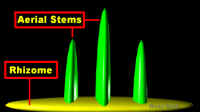 thalli and some
extant plants have retained this shape. These thalli would be similar to stems and
roots.
thalli and some
extant plants have retained this shape. These thalli would be similar to stems and
roots.
The first cylindrical
organisms probably had horizontal photosynthetic stems called Stolons.
Specialized, absorptive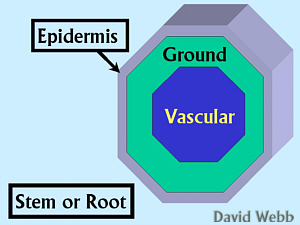 underground stems
called Rhizomes developed later and eventually upright,
aerial, photosynthetic stems arose.
underground stems
called Rhizomes developed later and eventually upright,
aerial, photosynthetic stems arose.
All of these had a simple Tissue organization of with Vascular Tissues in the center, surrounded by Ground Tissue and Epidermis.
Initially, all of these Organs had one central strand of Vascular Tissues (Xylem & Phloem), a cylinder of Photosynthetic Parenchyma (Chlorenchyma) and an Epidermis.
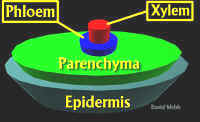 |
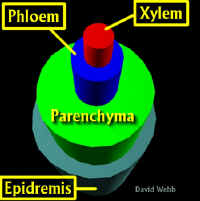 |
| Cross-Section of a Flat Thallus showing the internal Tissues | Cross-Section of a Cylindrical stem showing the internal Tissues |
The Psilophyta illustrate these evolutionary advances.